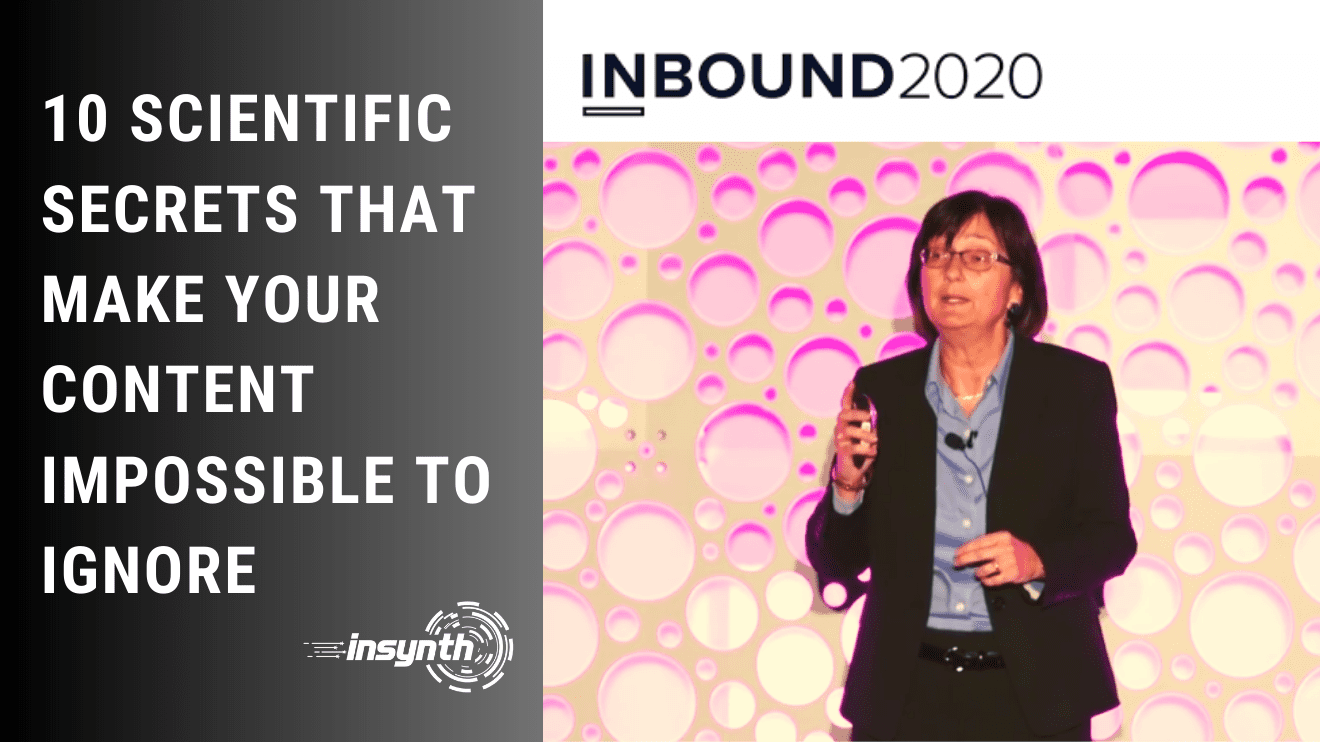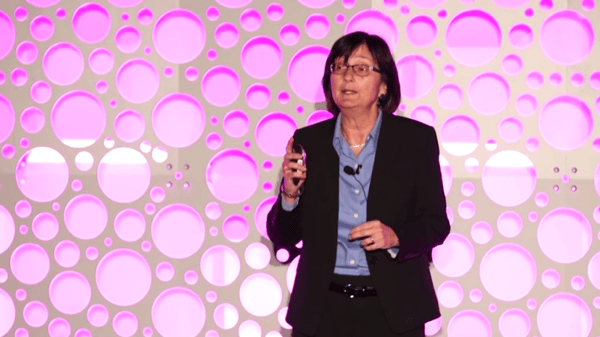6 min read
LIVE@INBOUND2020 10 Scientific Secrets That Make Your Content Impossible to Ignore
Freya Oxton-Grant
:
22-Sep-2020 15:03:05

The 22-23rd September 2020 mark this year’s Inbound Conference (#INBOUND2020), the massive 2 day conference that gathers business professionals from almost every industry, which has gone virtual this year in the light of the Coronavirus pandemic. Inbound 2020 is set to be an immersive, interactive digital experience uniting forward-focused professionals with industry thought leaders to cover everything marketing, sales and customer experience.
As part of our participation in the event, we want to bring you the best of the offering there through blogs and our social media. Stay tuned for more blogs like this. But now, let’s begin on the 10 Scientific Secrets That Make Your Content Impossible to Ignore, as delivered by Nancy Harhut.
Nancy is an Online Marketing Institute Top 40 Digital Strategist and the winner of numerous International ECHO awards for marketing effectiveness. She knows everything there is to know about the impact of behavioural science on marketing, and this is why her session was so impactful. The knowledge she gives is all backed by scientific research and social science studies!

As a marketer, we often are faced a difficult task, getting already information-overloaded consumers to pay attention to our marketing messages. I recently read a funny statistic that it is apparently 475x more likely you will survive a plane crash than click on a banner advert!
That is why I was so interested to watch Nancy’s session, to see what the science was going to say about how we can actually engage consumers and drive a response or behaviour change that we want, through marketing. And boy, did this session deliver! 10 proven, easy to apply tactics to instantly improve campaigns were served on a silver platter, and all backed up with special brain science!
The 10 Secrets You Need to Know for your Content Marketing
The human brain doesn’t like any rational thinking meaning when in a customer role, they are relying on decision making shortcuts. The brain’s automatic instinctive response is to conserve mental energy. This is because we couldn’t possibly take in every bit of information we see; it would just be way too much overstimulation.
Therefore, we default to hardwired behaviours when we receive stimulus. The social scientists have identified these automated responses to what we read, who we trust, and what we buy giving us a way in to triggering these automatic responses in marketing.
#1 Words That Make People Pay Attention
People don’t read a line at a time, they scan. If something catches their attention that is when they then fully consume it. Interestingly, some words have the power to leap off the screen and attract us like a magnet. Research such as eye tracking, MRIs, and heat mapping have been used to find out- what makes the brain light up?
New, Now, Introducing, Soon: The brain likes to seek out what is new and novel. If we think something’s new, it triggers a reward response in us, releasing dopamine. Simply, it feels good to feel new.
Free: Free things have an immense pulling power, emotional charge and value to the brain. We have to have it. Nancy stated that research shows if you use the word ‘free’ in your email’s subject line you can receive twice as many opens.
You: A very persuasive word as everyone knows, we are more interested in ourselves than anybody else. In your content downplay ‘we’ and ‘I’ and increase ‘You’.
Secrets, Truth, Sneak Peek: As evidenced by the title of the session, we are persuaded when we feel information is not widely available.
#2 Pictures That Make People Pay Attention
Pictures were around before words, and this is partly due to why the brain remembers them longer. As cavemen, if we encountered a stranger we would need to quickly decide if they were a friend or a threat. The use of eye contact in pictures is an immediate way to pull people in.
Another way to use eye contact, however, is to use an eye gaze. We look to see what the person in the picture is looking at and so that’s where you should place your CTA. We will follow that gaze right to the honey pot, without even thinking.
Another important element Nancy mentioned was the use of a dashed line. It gives us the impression it is a coupon and a good value offering for us, drawing us in. Using a dashed border around an image or text box immediately makes us look or read what’s inside.
#3 Two Ways to Make Your Message Irresistible
In marketing it is all about engaging customers and getting them to respond right away. Don’t let them get away and ‘come back to it’ because you know they never will.
Scarcity Principle: Proven by science, humans are more interested when there is a scarcity surrounding a product or service. If its readily available, we are less interested, but if not, we want it badly. This causes urgency in our response.
A visual way of doing this is using text like ‘flash sale’ or an integrated ‘countdown clock’ on your page. This triggers a visceral response and is stated to increase clicks by 31%.
Exclusivity Principle: If something is premium or reserved for you it makes you feel special and exclusive. The benefits, or privilege you get, makes you feel good and is another incredible way to trigger a response.
#4 What to Say First When People Aren’t in The Market
If you can’t seem to connect with customers and they often say no you need to tap into something called availability bias. As humans, we often judge likelihood of something happening based on whether we can recall an example. Say you are scared of being in a plane crash because all you ever hear is bad things that happen to planes.
Before you ask them to buy something from you, ask them whether in the past your offer would have been useful, or even would be in the future. You can even phrase it such as ‘have you heard your colleagues saying’.
Using a rhetorical question makes them ponder whether something COULD happen, and whether they should reconsider.
#5 Fastest way to convince sceptical prospects
If you are talking to someone who is in the market, but they are not sure that you’re the right source, using storytelling is a powerful way to make customers change their mind. Storytelling is an incredibly effective tactic for marketers because when you read a story you make your own conclusions and reflections on what occurred.
And you rarely argue with your own conclusion.
This is a great way to get around someone who is sceptical; you make them turn their own mind around.
#6 Easy Way to Get People to Trust You
Getting customers to trust us as a credible source or business is hard to do when they don’t know anything about you. This is why Nancy suggests we tap into social proof. This is when people who aren’t sure look to others like themselves for confirmation. They do what others do.
Therefore, we can gain customer’s trust through testimonials and reviews. They won’t believe staff or an ‘about’ page, but they will trust people/customers like themselves. You can also use this in your marketing copy such as ‘come and see why your neighbours love us so much’.
#7 Make Savings Big and Prices Small
The neuroscience shows that, apparently, the act of paying and the response that is causes in our brain is actually found in the same spot that physical pain is found. The pain of paying is a real thing!
By tapping into what Nancy states is the ‘magnitude encoding process’ we can work around the psychology of paying such as by displaying prices in different ways. We can change how we perceive cost. For example, using 2 decimal points in a price such as £130.00 makes the value seem larger, therefore should be avoided.
However, this trick can be conversely applied when stating savings, making the savings seem larger to us. Another interesting thing that was said was that men actually find prices in red actually more attractive as if they have a greater value.
#8 Why Negatives Can Deliver Positive Results
In marketing is seems to always be all about benefits, but what about the negatives? Loss aversion is an incredible influence on us with people being twice as motivated to avoid the pain of loss than they would be to achieve pleasure of again.
In your content, talk about the pain your customers can avoid if they follow through with your CTA e.g. ‘don’t miss’ or ‘the biggest mistake’.
#9 How to Create A Ripple Effect
In business we want continuation. We want lifetime customers not just one sale or engagement. By tapping into the commitment and consistency principle we can keep customers charmed. If we can get customers to say yes once we are more likely to get them back, and this is especially true if the first ask is small e.g. like us on Facebook
You can then over time increase that ask and, as Nancy nicely articulated, you can achieve a “cascade of yesses!”
#10 What Instantly Makes You Look Better Than the Competition
The concept of having a USP isn’t everything anymore. The market is tougher and competitors are similar, with everyone always seeming to have the ‘best customer service’.
The final psychology secret is the use of the authority principle. Since childhood we have been taught to respect and abide by authority, and this is why it is still so effective. By using copy like ‘the experts agree’ or ‘approved by’, we gain a certification that is influential in the decision-making process. This can make us stand out against competitors.
A way this could be applied that is specific to our construction and building product industry, is the visual trust we gain when we display the logos of our accreditations from third party authority bodies when we put them on our website or social media.
In Summary:
- Choose eye magnet words
- Feature faces
- Leverage urgency and exclusivity
- Spark memories
- Draw their own conclusions
- Let customers speak for you
- Make savings big and prices small
- Avoiding pain beats achieving gain
- Get that first small yes
- Invoke experts
I hope you liked being part of the ‘exclusive’ group which learned the content ‘secrets’ you need to know to make your content ‘expert approved’! See if you can implement any of these tactics into your company’s website and marketing. And if you’re keen to learn even more from Nancy then check her out on Youtube as well as her Twitter @nharhut.
About Insynth
Insynth Marketing is a leading UK construction marketing agency based in Shifnal in the West Midlands.
They use the latest inbound marketing techniques such as construction inbound marketing, to support building product companies to grow their business by proactively driving sales lead generation activity.
As the only HubSpot certified agency to major on construction marketing, we bring together construction marketing strategy, digital strategy, website design, SEO, content marketing, email marketing, sales automation, marketing automation and HubSpot CRM implementation to produce successful campaigns and great results for our clients.
